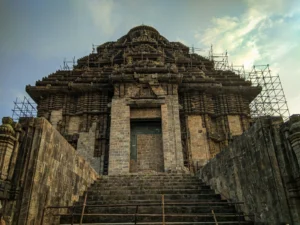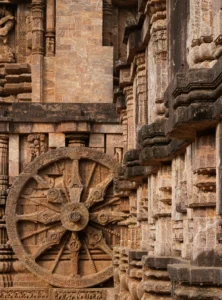The Konark Sun Temple located in Konark, Odisha, is a 13th-century temple earmarked to the Hindu god, Surya. It is located about 35 kilometers from puri city on the coastline of puri district, Odisha India. It is the pinnacle of Hindu Orissan architecture. earmarked to the Hindu sun god Surya, it reflects the pinnacle of Kaligan architecture and artistic excellence. Konark Sun temple is depicted on the reverse side of the Indian currency note of 10 rupees to signify its importance to Indian cultural heritage.

Why is Konark Temple called the Sun Temple?
The name ‘’ KONARK” itself combines ‘’KONA ‘’ (corner) and ‘’Arka ‘’ (sun) , further indicating its consecration to the sun god. The Konark Sun Temple is called a sun temple because it was specifically built to honor the sun God Surya and is designed in the shape of a chariot drawn by seven horses.
Table of Contents
ToggleArchitectural Features of Konark Sun Temple:
Konark sun temple, which was built by king Narasimha Deva I of the eastern ganga dynasty, located in the eastern coast of Odisha ,features intricate cravings and is a significant example of Kalinga architecture . The present-day Sun Temple was probably built by King Narashimha I (1238-64) of the Ganga dynasty to celebrate his victory over the Muslims. It fell into disuse in the early 17th century after it was perverted by an envoy of the Mughal Emperor Jahangir.

Symbolism and Concept:
- The Konark sun temple , is a symbolic representation of surya, the sun God and its chariot journey across the sky. It’s a magnificent example of Kalinga architecture and intricate craving that inter wine art, science and spirituality .
- The temple design,including 24 wheels and 7 horses, carries deep symbolic meanings related to time. The temple is designed as a gigantic chariot, representing the surya’s journey across the heavens.
- The 24 wheels correspond to the 24 hours of the day , the 12 months of the Hindu calendar ,and the 12 pairs of wheels symbolise the cycle of death and rebirth.
- It was a significant trading port by the early centuries of the Common Era.
Intricate Carvings and Sculpture:
The Konark temple is renowned for its carvings, which portray a wide array of scenes from daily life , Hindu mythology, and celestial beings. These cravings ,particularly the erotic sculptures known as “mithuna’’ showcase the artistic and cultural richness of the time and reflect the belief in intimacy as a natural part of life.
Sculptures of gods and goddesses , each with unique poses and expressions are reflecting the divine aspect and religious belief. These cravings, while contentious, are an important part of the temple’s art and reflect the ancient Indian belief in the importance of intimacy and gratification in human life.
The temple features numerous sculptures depicting hindu deities like Vishnu, Lakshmi ,Durga and others with unique poses as well as expressions. The temple also features lion and elephant guardians at the entrance, which are interpreted as the symbolic representation of Rajas overcoming Tamas.
Konark Sun Temple has a manifestation of a 100-foot chariot with humongous wheels and horses, which are all carved from stone. It features intricately carved panels and friezes, including erotic sculptures, scenes of everyday life, and depictions of animals and deities.

Engineering and Construction Techniques:
The Konark sun temple showcases remarkable engineering ,utilizing three types of stones and innovative techniques like the buried construction method and sophisticated joining system to achieve its architectural grandeur. The temple was built by placing stones, interlocking them, and using lime mortar for reinforcement. Khondalite was used for structural elements, laterite for foundational purposes, and chlorite for ornamental sculptures and doorframes. Lime mortar was used to strengthen the walls, and natural binders were used to join the stones.
The temple design incorporated astronomical knowledge, with the wheels serving as sundials and the orientation allowing the first rays of sunlight to fall on the main entrance. The Sun Temple was made from three types of stone. Chlorite was used for the door lintel and frames, as well as some sculptures. Laterlite was used for the core of the platform and staircases near the foundation . Khondalite was used for other parts of the temple.
Why is Konark Temple famous?
The Konark temple is famous for its unique architectural design, which features a grand chariot of the sun God, SURYA, complete with intricately carved wheels and horses. The temple’s intricate carvings depict scenes from Hindu mythology and daily life, showcasing a mythology of art and culture. The temple is a prime example of Kalinga style of architecture, known for its grandeur and intricate details.
The temple plan includes all the traditional elements of a Hindu temple set on a square plan. According to KAPILA VATSYAYAN, the ground plan as well as the layout of sculpture and reliefs, follow the square and circle geometry, forms found in Odisha temple design text such as the SILPASARINI. This mandala structure informs the plan of other Hindu temples in Odisha and elsewhere.
Conclusion:
The Konark sun temple stands as a testament to the architectural and artistic prowess of ancient India. Its intricate cravings, grand design, makes it a remarkable monument, representing the sun God Surya and a chariot of sun.For further reading on the Konark Sun Temple’s recognition, check its official UNESCO World Heritage Site listing here. While its history includes both construction and deconstruction, the temple’s enduring beauty and the mysteries surrounding it continue to fascinate visitors and researchers alike.


